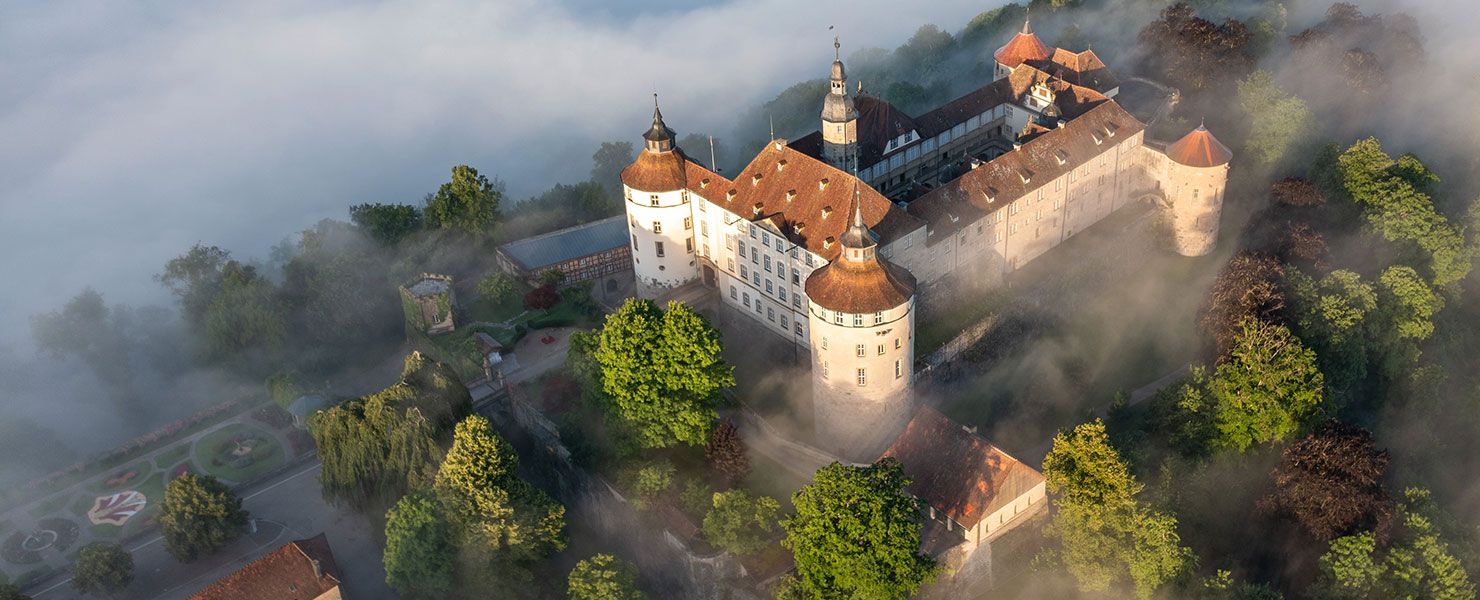Audio-Guide
Walk around the castle –
a guided audio tour
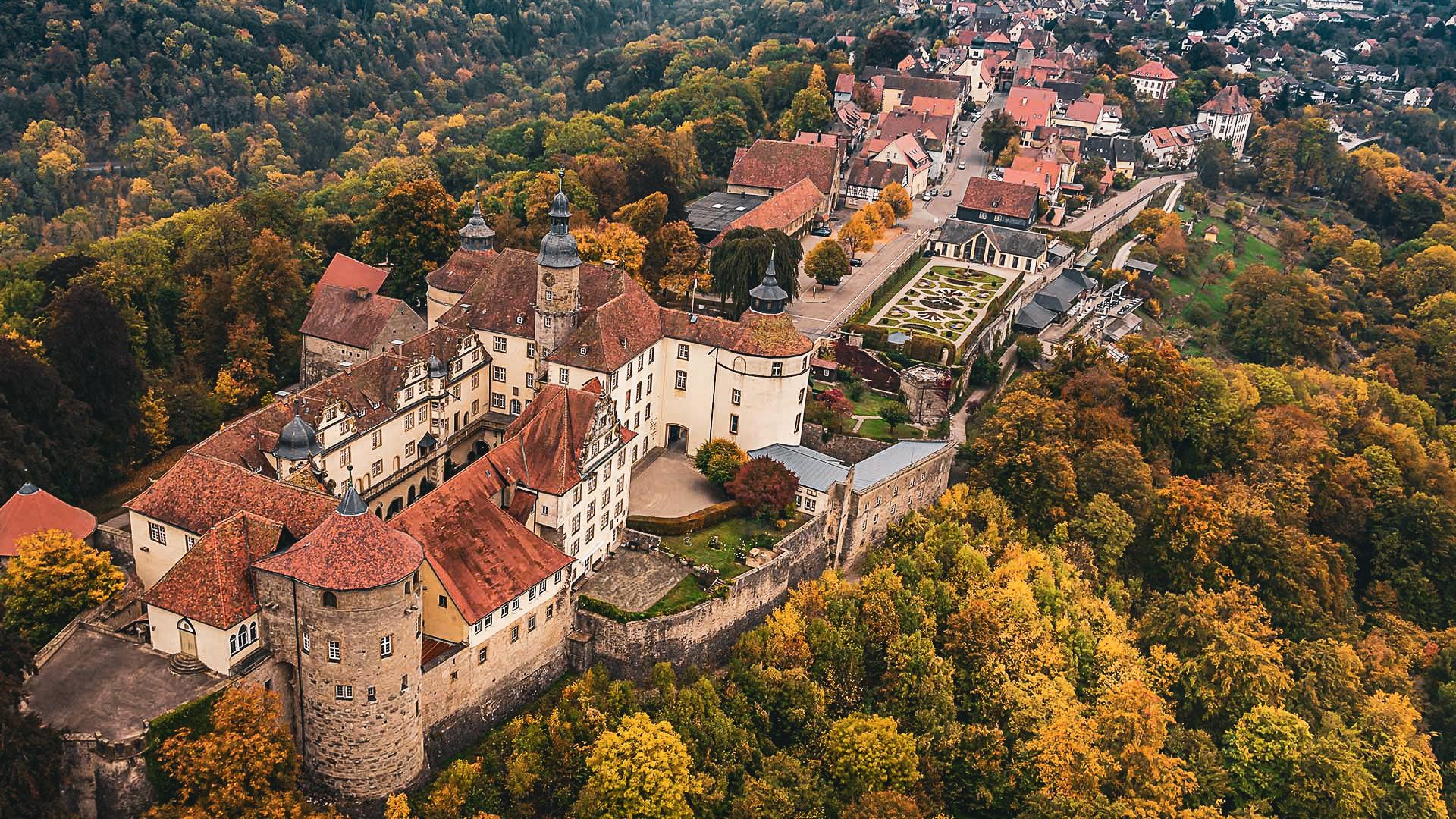

The little tea tower, a dog cemetery, the view of the Jagst valley, but also the enchanted corners of the castle park – a walk around Langenburg Castle has many a surprise in store. And on hot days, our guests will find a cool spot in our pergola.
Audio-Guide Castle walk
Our audio guide walk takes you on a tour of the castle with lots of information. There are QR code signs at 9 stations that you can scan with a smartphone.
01 – Welcome at the castle
M: Welcome to the gates of Langenburg Castle!
W: We are delighted to be able to take you on a walk around our castle today. We will guide you through our princely gardens with plants and trees that were once part of the English park landscape. You will come across an enchanted tea tower and a beautiful animal memorial.
M: The history of our castle goes back to the Staufer period in the 12th century. Since the 13th century Langenburg Castle has been in the possession of the Princely Hohenlohe family. In 1610, Count Philipp Ernst made the castle his residence and had it converted into a Renaissance palace.
W: A century and a half later, between 1757 and 1759, parts of the castle were remodelled in the Baroque style. The east wing, which you are looking at, was given an almost classical façade. Take a look at the top. There you will see the unusual date 1966 on the gable.
M: It’s the year of the reconstruction. In January 1963, a major fire destroyed the entire east wing and part of the north wing.
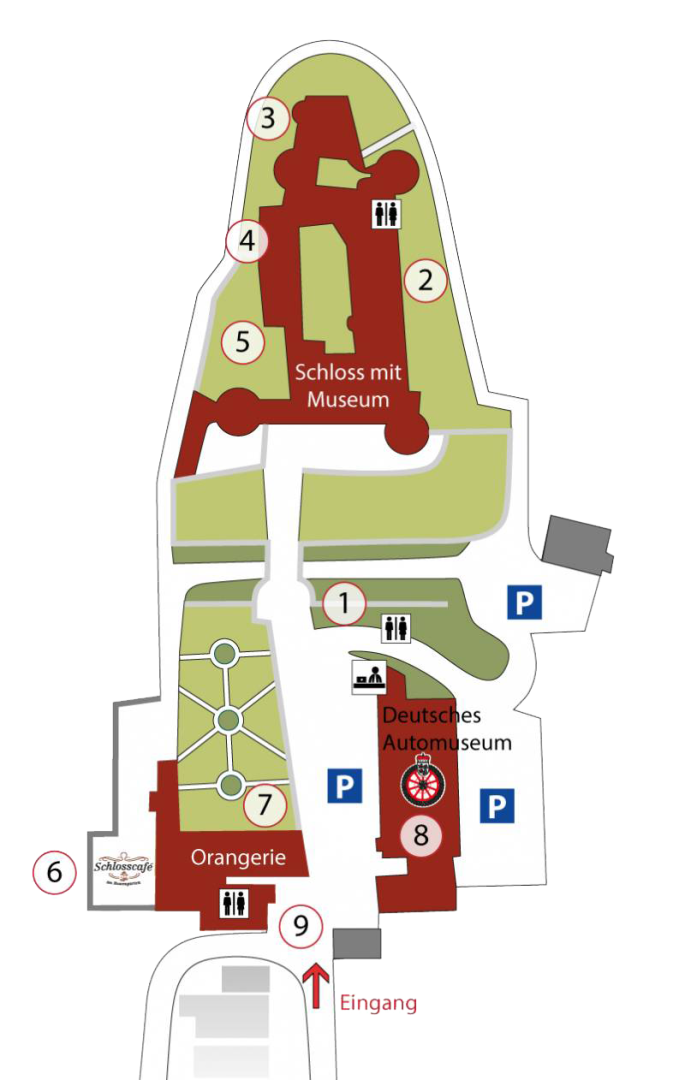
02 – Shooting range
M: The Hutzel Tower with its cheeky red hat marks the rear corner of the castle wall, behind which is the north wing with the castle library, private living quarters and guest flats.
W: Shooting practice and competitions used to take place on the area in front of the castle. Hence the name shooting range. The princely families later also used it for sporting activities, including playing tennis here. You can see a historical picture of the shooting range on the board. The stone bench you see in another photo is now located in the entrance area of the castle on the left-hand side.
M: You can still see from the embrasures in the tower that the castle was once a defensive structure. They were not only used for firing, but also for pouring tar and pitch to protect the castle from attackers.
W: Today, the shooting range is a thoroughly peaceful place where falcons and jackdaws also live in harmonious coexistence.
M: You will reach your next stop, the tea tower, if you follow the path and then take the steps on the right-hand staircase.
W: The left staircase leads up to the castle. Behind the castle wall lies the Zwinger, a former defence base. It is not worth going up, as the door is merely the exit through which you leave the castle after a guided tour.

03 – Tea tower
W: And another enchanted turret! Listen to his story!
M: At the beginning of the 19th century, after the Princes of Langenburg had lost their sovereignty, they began to return to their home castles. They spent a lot of time on garden design and planning. Prince Karl Ludwig was the first to dare to remodel the palace again after the Baroque period. He brought great garden designers and romantic country house architects to Langenburg, including the court architect Johann Gottfried Klinsky. According to his plans, the gardens were to be remodelled like an English landscape garden. Just like it was fashionable back then.
W: Many of these plans were realised, but most of them only under Prince Herrmann from the middle of the 19th century by his court gardener Lebl.
M: The tea tower was built for the princess and the princesses so that they had a little change from their everyday lives at home in the castle. Here they had a place where they could spend their free time. They painted, embroidered, sewed, read and – drank tea.
W: The high walls next to the tea tower are part of the Lindenstamm bastion, one of the oldest parts of the castle. With its thick walls, it protected the castle and its inhabitants from intruders. The walls date back to the time of the castle complex, i.e. from the 12th century.
M: When you visit the castle, you can step out onto the viewing platform of the Lindenstamm and enjoy a wonderful view over the Jagst valley. However, most people are surprised to see beech trees instead of lime trees!
W: So the vegetation changes over time. Your path continues along the castle wall. After a few metres, where the bench is located, is your next stop.

04 – Dog cemetery
M: Zidane, Aram, Argo, Robin, Knerz, Rowly, Watson and Zacky – the dog cemetery on Karl-Ludwigs-Platz is the burial place for the favourites of the princes and princesses of past centuries.
W: Zidane and Watson were Labradors, Aram was a German Shepherd, Argo was a Brazilian Bloodhound, Robin was a Terrier, Knerz was a Longhaired Dachshund, Rowly was a King Charles Spaniel and Zacky was a Yorkshire Terrier.
M: Rowlie is the oldest deceased dog. He entered the eternal hunting grounds in 1856. However, we do not know whether he is actually buried here. The stone was probably set later.
W: The dog that was demonstrably the first to be buried here – it’s the gravestone in the centre – was Knerz, Prince Herrmann’s long-haired dachshund. He died in 1888. Prince Herrmann had ordered the dog to be put to the wall at Karl-Ludwigs-Platz. Since he had given him so much pleasure and had served him so faithfully on the hunt. The grave inscription is difficult to decipher. It reads: “In memory of dear Knerz, November 1888”.
In keeping with this tradition, to this day only the special favourites of the royal family receive a tombstone. This is because many more dogs have lived at the castle over the centuries.
In the 1590s alone, 73 dogs barked, watched and hunted here, according to the records.
M: Nowadays, deceased dogs are no longer buried here. But they are given a tomb. Zidane, Prince Philippe’s Labrador, who entered the eternal hunting grounds in 2015, is no exception. He was given a historic gravestone so that it would fit in well with the ensemble. In 2004, when Prince Philipp became lord of the castle, Zidane was promoted from lap dog to castle dog.
Now follow the path through the pergola to our rose garden.

05 – Rose garden
W: Breathe in the sweet scent of roses and enjoy the marvellous view over the Jagst valley.
M: Your way here led you through an arcade. It was already laid out during the remodelling into an English garden. But he was gone for a long time. In 1998, Prince Kraft once again invested a great deal of energy in restoring the castle and garden to their former state. He had the arcade rebuilt according to the old plans. The cool trees are hornbeams.
W: But now to the rose garden: it is laid out on two levels with red and pink blooming roses, with rose bushes to the left of the wall. What a fragrance! The dog roses are called robber roses and their spherical flowers are pink. The same rose varieties as here also grow in the baroque garden, which you will see in a moment.
M: If you keep walking, you will see an old gnarled tree on the left. It is a mulberry tree. It is actually at home in subtropical regions. But in its location on the heat-reflecting wall, it develops wonderfully. The Russian Tsar Nicholas the Second gave it to Prince Ernst the Second and Princess Alexandra as a wedding present in 1896. It has been here ever since, more than 125 years. In summer, when it sheds its berries, the ground beneath it is blood-red in colour.
W: There is a Japanese cherry tree on the right in front of the castle café. In spring it is adorned with pink blossoms – for around ten days – then the cherry blossom splendour is over. At the same time, people in Japan celebrate Hanami – the cherry blossom festival.
M: At the next stop you will see our castle café. Step out onto the terrace.

06 – Castle café
W: The castle café with its wonderful view over the Jagst valley was opened in 1950, ten years before the opening of the castle museum. It was the start of tourist operations here in Langenburg. Anfangs war das Café ein offenes Gebäude. We later installed windows so that our guests can now enjoy this wonderful view even when it rains. After a section of the wall slipped in in the 1980s, we extended the terrace again. Today, the castle café has 150 seats outside and 150 seats inside. Here our guests can enjoy a coffee, ice cream or Black Forest cake before or after a visit to the castle.
M: You are welcome to take a seat now – or come back later. Your tour continues. Please take the path back through the rose garden and then turn right up the steps towards the drawbridge that leads over the moat.
W: The moat was originally part of the fortifications. In the 19th and the 20th century it was integrated into the gardens and park. The flower pots that stand there are all from the years 1870 to 1890.
M: At the top, please turn right and continue to Lindenplatz. From the parapet wall you can look out over the baroque garden.
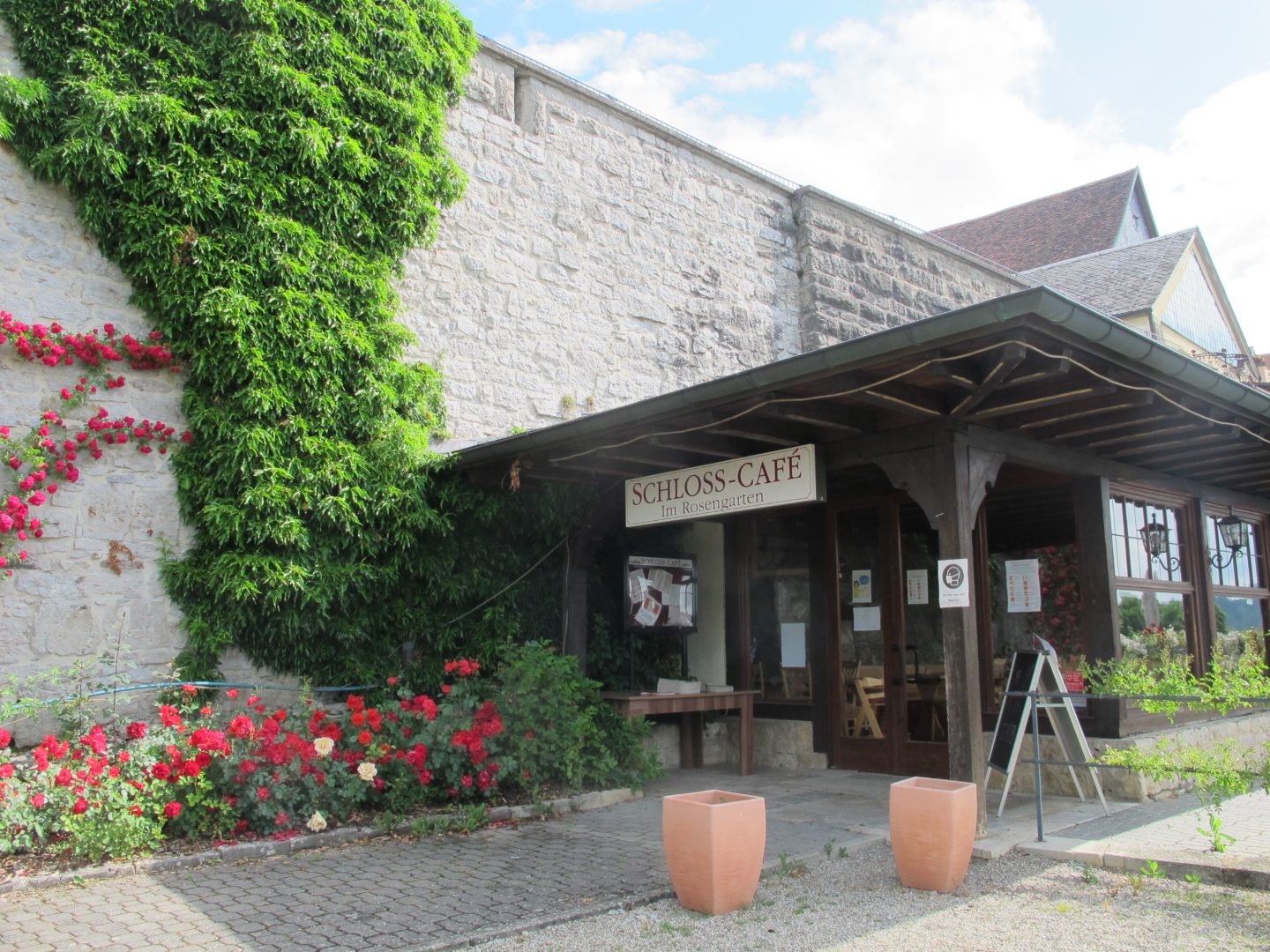
07 – Baroque garden
M: Our baroque garden can only be visited by guests of the Orangery, which is located at the end of the garden. Weddings are now celebrated in the building where oranges, lemons and pineapples were once grown and stored. The first orangery was built in 1756. Fürst Ernst der Erste ließ 1853 das zerfallene Gebäude wieder aufbauen. Since the orangery was restored in 2005, it has been used as an event location. Once a year, during the Princely Garden Days on the first weekend in September, the garden is also open to visitors.
W: Many counts and princes have worked on the baroque garden. Count Philipp Ernst had it built at the beginning of the 17th century as a pleasure garden with two garden terraces. Under Prince Ludwig in the middle of the The garden was redesigned into a baroque garden in the 18th century. The rose arches were also created at that time. The first fountain was built in 1776, the current fountain was built around 1900.
M: In the middle/end of the 19th century, Prince Herrmann brought the gardener Lebl from Schönbrunn near Vienna to Langenburg. He decorated the garden with rose pergolas and ornamental greenhouses. Prince Kraft had it restored again in 1993/94. Today, Princess Saskia makes sure that the garden is green and blooming.
W: The plants flower in shades of red and white – the colours of the Hohenlohe family. Their flag is red and white striped. If you look towards the castle, you will see them fluttering in the wind high up on the roof. The flag used to indicate whether the princely family was at home; if it left the house, it was withdrawn. Today, she is signalling that Langenburg is her main place of residence. The magnificent family flag with coat of arms is only hoisted on special occasions in the castle, such as birthdays or christenings.
M: There is only one baroque terrace like this in Baden-Württemberg. Your next stop is at the old stables, directly opposite.
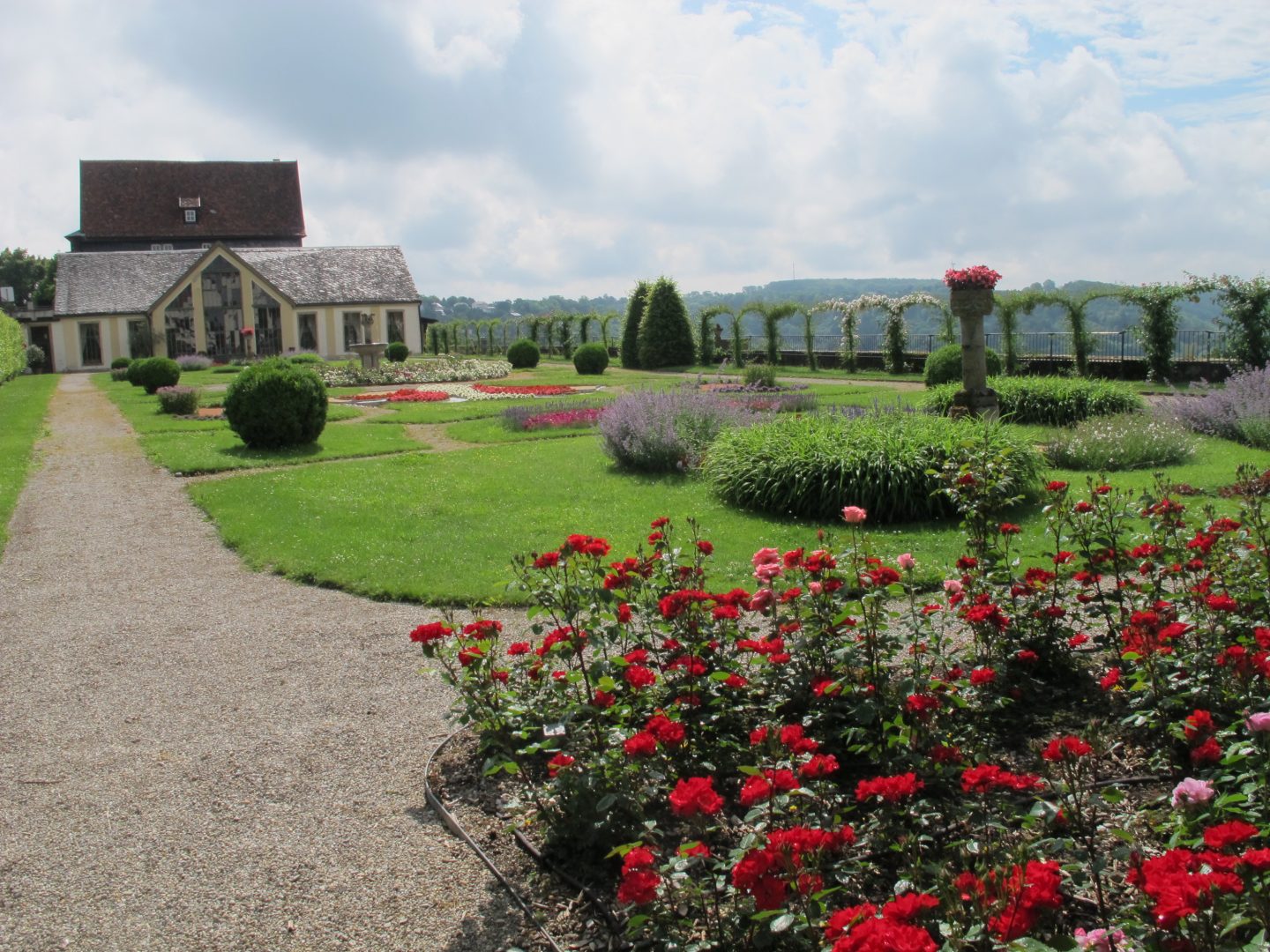
08 – Marstall
W: You are standing in front of the castle’s former stables, which were used by the Princes of Hohenlohe-Langenburg from 1450. In front of the stables – where the car park is today – was the showground and riding arena.
The stables are one of the oldest stone buildings in Langenburg, together with the neighbouring building, the Fruchtkasten, about which we will tell you more in a moment. The northern part of the building once housed the dairy with its farm and cowshed.
M: In 1970, the German Automobile Museum moved into the Marstall – with many classic cars, including the Mercedes limousine in which Queen Elizabeth visited Langenburg Castle in 1965. Today, you can still admire some vintage cars here.
W: The staff flats used to be on the upper floor. Today there are two spacious holiday flats, which were furnished by Princess Saskia with great attention to detail.
M: The stone house to the right of the stables used to be called Fruchtkasten. The 17th century building was used as a warehouse for fruit and grain. This was where farmers handed in their tithe, the tax they had to pay in the form of a tenth of the crop yield.
W: Take a look at the beautiful stepped gable and what a wonderful contrast it makes to the flat-roofed stables and the neighbouring half-timbered buildings!
M: Later, the fruit box served as a coach house for the royal family’s carriages. The name Remise has remained. Under its roof is now an event location with a rustic flair.
W: The beautiful half-timbered house to the right of the coach house is the old coachman’s house, where the coachmen and foresters used to live. Today there are two holiday flats under the roof of the listed building.
M: The Hofratshaus opposite is the last stop on your walk.
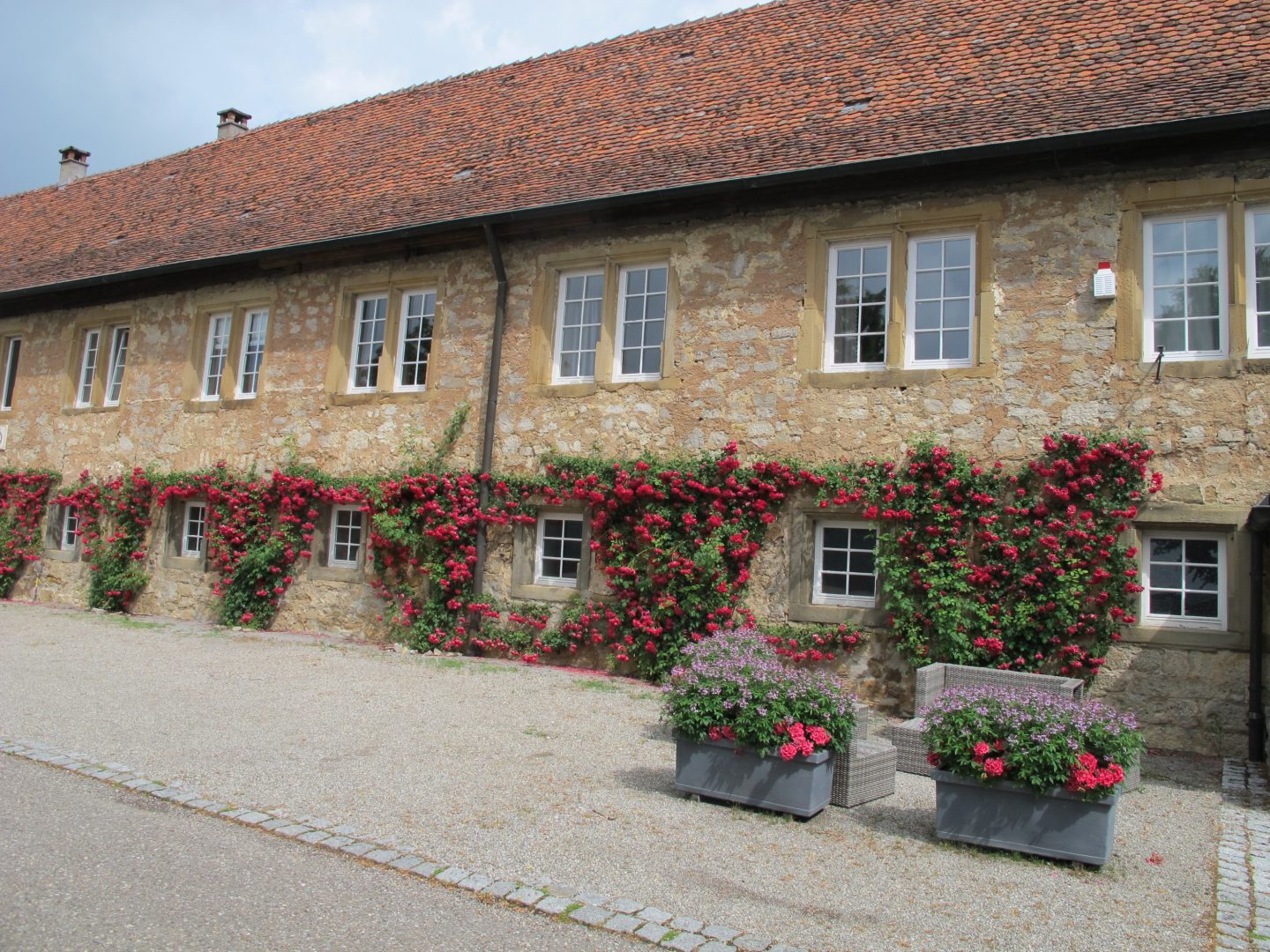
09 – Hofratshaus
M: The detached Hofratshaus was built in the 17th century as a residence for civil servants. It was extended to the south in 1911 and renovated in 1994. The half-timbered house has been home to the Hohenloher Kunstverein for many years. Exhibitions by contemporary artists are shown on the upper floor. A visit is worthwhile.
W: Last but not least, we would like to invite you to visit our castle. Take a tour, join a guided tour and immerse yourself in the eventful history of the Hohenlohe-Langenburg royal family. You can also expect an enchanted castle chapel, one of the most beautiful Renaissance courtyards in southern Germany, a beautiful baroque hall and – as promised during the tour – a fabulous view from the Lindenstamm over the Jagsttal valley.
M: We hope you enjoyed your walk and we’ll say goodbye to you now. But maybe we’ll see you in the castle café with a cup of coffee – and a marvellous view.
W: Goodbye!
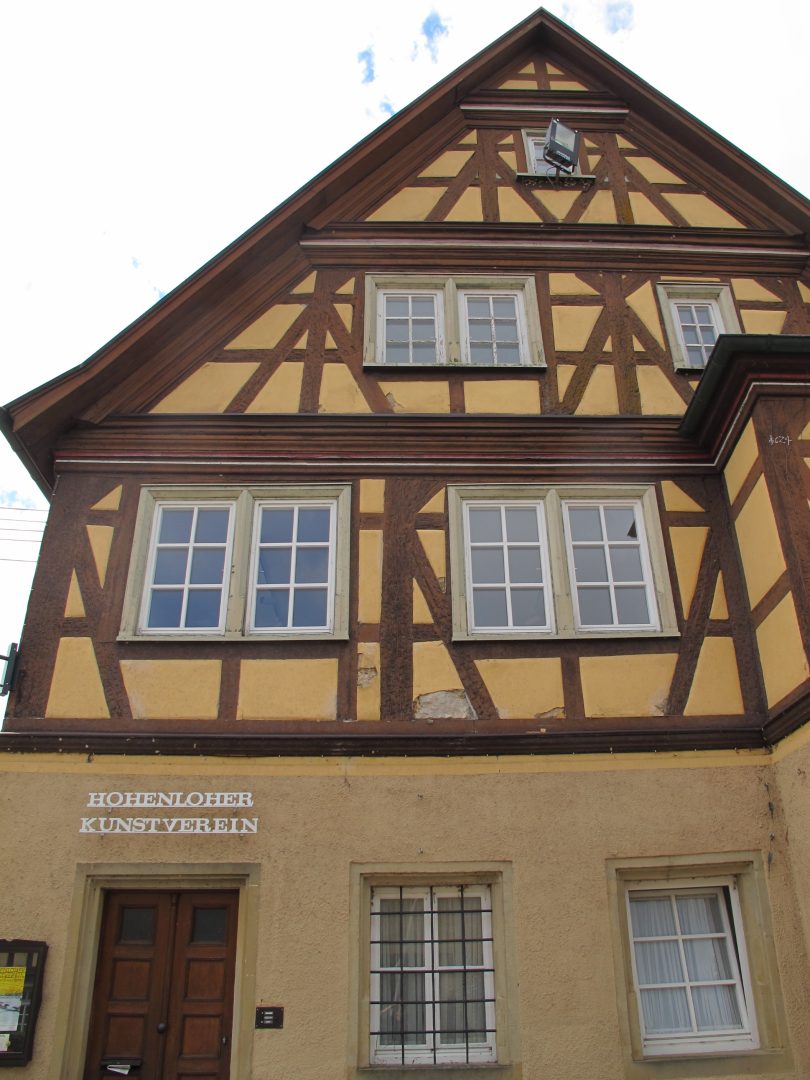

Discover the history & traditions of Langenburg castle
Get to know one of the most important historical cultural monuments in southern Germany in a variety of ways.
